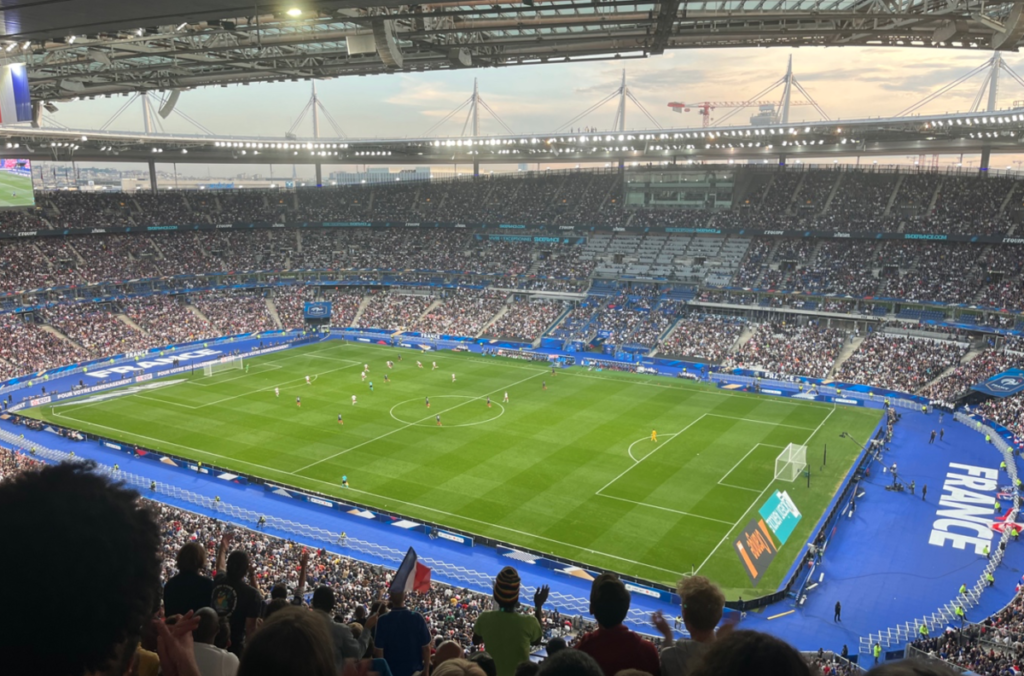by Samantha Feingold
“Does anyone know what Rugby actually is?” This question floated around in several variations the week before we were to attend a France vs. Denmark rugby match.
“What?” asked our waiter several times before it was evident we weren’t pronouncing it well enough for him to understand. Lauren gestured throwing a rugby and he finally understood, but said he didn’t know the sport well enough to explain. While the restaurant is nearby our apartment and we have eaten there enough times for this waiter to recognize us when we walk past, an Italian restaurant maybe wasn’t the best place to ask about rugby.
“It’s like football but without helmets,” said a peer. It is important I emphasize at this time she was referring to American football. This statement left me more confused as helmets and padding seem to be the most important part of football, a high contact sport. Research on retired football players with chronic traumatic encephalopathy (CTE) has amplified in conjunction with the increase of media coverage on cases of severe cognitive deterioration and changes in mood in famous players (Buckland et al., 2019). However, there are minimal studies on CTE and long-term negative effects on the brain for rugby players (Buckland et al., 2019).
Prior to the match, my peers presented a crash-course on rugby and an in-depth journal article review on rugby and CTE (Zimmerman et al., 2021). It quickly became evident that rugby is quite intense, and it was likely there would be many head collisions.
When we finally arrived at Stade de France, all the fans were bouncing with excitement and kids ran around with French-flag face paint. It wasn’t until we settled in our seats and the pre-match rituals concluded that we realized the peculiar goals and that what in front of us resembled European football far more than having any parallels to American football (Figure 1).

While we did not see rugby that evening, we were lucky enough to watch a qualifying match for the World Cup (Figure 2)! Within minutes of realizing this was soccer and not rugby, it became evident that instead of being tackled, there was risk for brain injury from repeatedly heading the soccer ball. The potential force exerted from heading ranges from 500-1200 Newtons (Teymouri et al., 2012) and is equivalent to a maximum of over 250 pounds-force (lbf). While this is not quite the impact of a moving 300+ pound American football player, the European football players are (like the elite rugby players) not wearing helmets. Thus, while soccer is very entertaining, it is important to properly teach young players how to head a soccer ball and be aware of the possible injury.

Works Cited
Buckland, M.E., Sy, J., Szentmariay, I. (2019). Chronic traumatic encephalopathy in two former Australian National Rugby League players. acta neuropathol commun 7, 97. https://doi.org/10.1186/s40478-019-0751-1
Teymouri, M., Sadeghi, H., Nabaei, A., & Kasaeian, A. (2012). The relationship between
biomechanical-anthropometrical parameters and the force exerted on the head when
heading free kicks in soccer. Archives of trauma research, 1(1), 44–48. https://doi.org/10.5812/atr.5307
Zimmerman, K. A., Laverse, E., Samra, R., Yanez Lopez, M., Jolly, A. E., Bourke, N. J.,
Graham, N., Patel, M. C., Hardy, J., Kemp, S., Morris, H. R., & Sharp, D. J. (2021).
White matter abnormalities in active elite adult rugby players. Brain
communications, 3(3), fcab133. https://doi.org/10.1093/braincomms/fcab133
